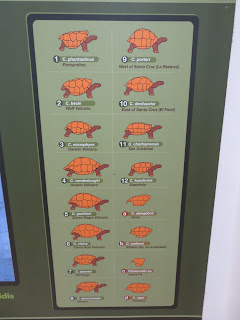Our last excursion was also with Pati. This time we traveled south along the coast to the main town in Santa Cruz. They are doing amazing work trying to repopulate the various islands. Each island has the same basic story, rats have been introduced to the ecosystem, voluntarily or involuntarily. These rats can eat the eggs of the tortoise or actually eat through the shells of the young tortoises killing them in the process. The adults are hardy enough to survive anything the rats can throw at them so the trick is getting the babies old enough to release them back on the island that they evolved on. Each stage of hatch-lings are separated based on their specific development stage. When a female laid eggs she dug a deep hole up to 3 feet deep, laid her eggs and then urinated on the refilled hole. The urine would help compact the dirt so that nothing could dig up the eggs and have a snack. As a result the hatch-lings may have taken up to a month to dig themselves out. So when they hatch at the research center they are kept in pretty close quarters with limited area to move around. They are kept in rat proof cages for the first two years to protect them. After a month or so they are transferred to cages where they can start to move about the terrain and build up strength. Different species are intermingled but each is numbered and they are different enough that each species can be identified. They have Lonesome George stuffed and on display. He was the last of his species but alas was never able to breed.

These wooden signs are incredible
That says it all
Intrepid Explorer
Great signs
The youngest tortoises are just about 3 to 5 inches in diameter
Keeping track of the youngest
The second level of maturity
Keeping track of all of the tortoises
The water is there sometimes and not there at other times like it will be when they are released
Almost ready to be released
#24 is in the lead
A tall shell allows the tortoise to reach higher to get food
The top of the shell is called the saddle
And a long neck to reach more grub
Some species are larger than others
Much less of a saddle, this island may have plentiful food lower down
Super long neck
Lonesome George







































































